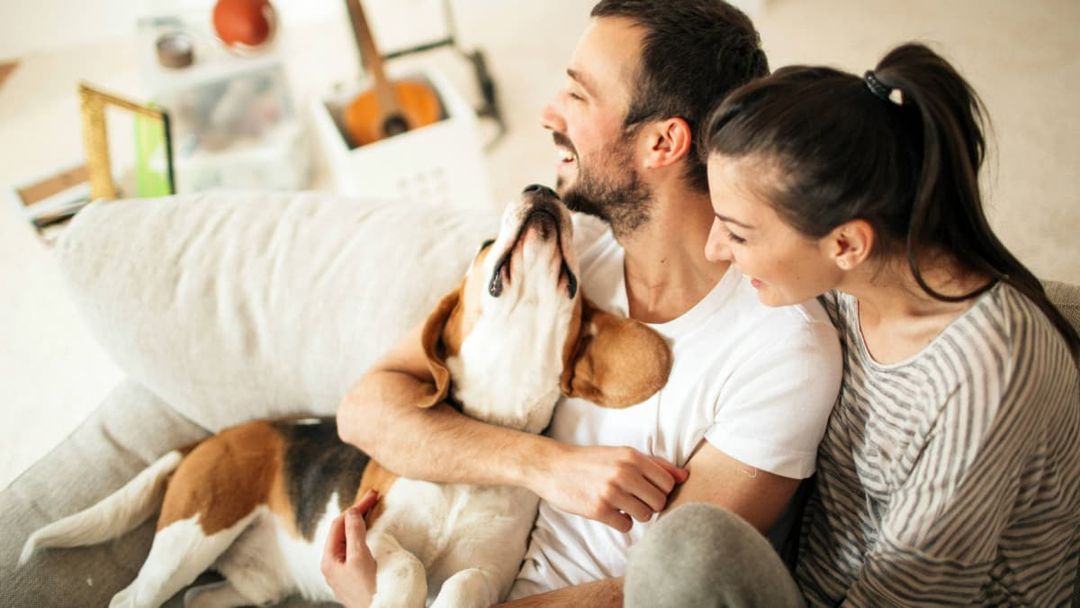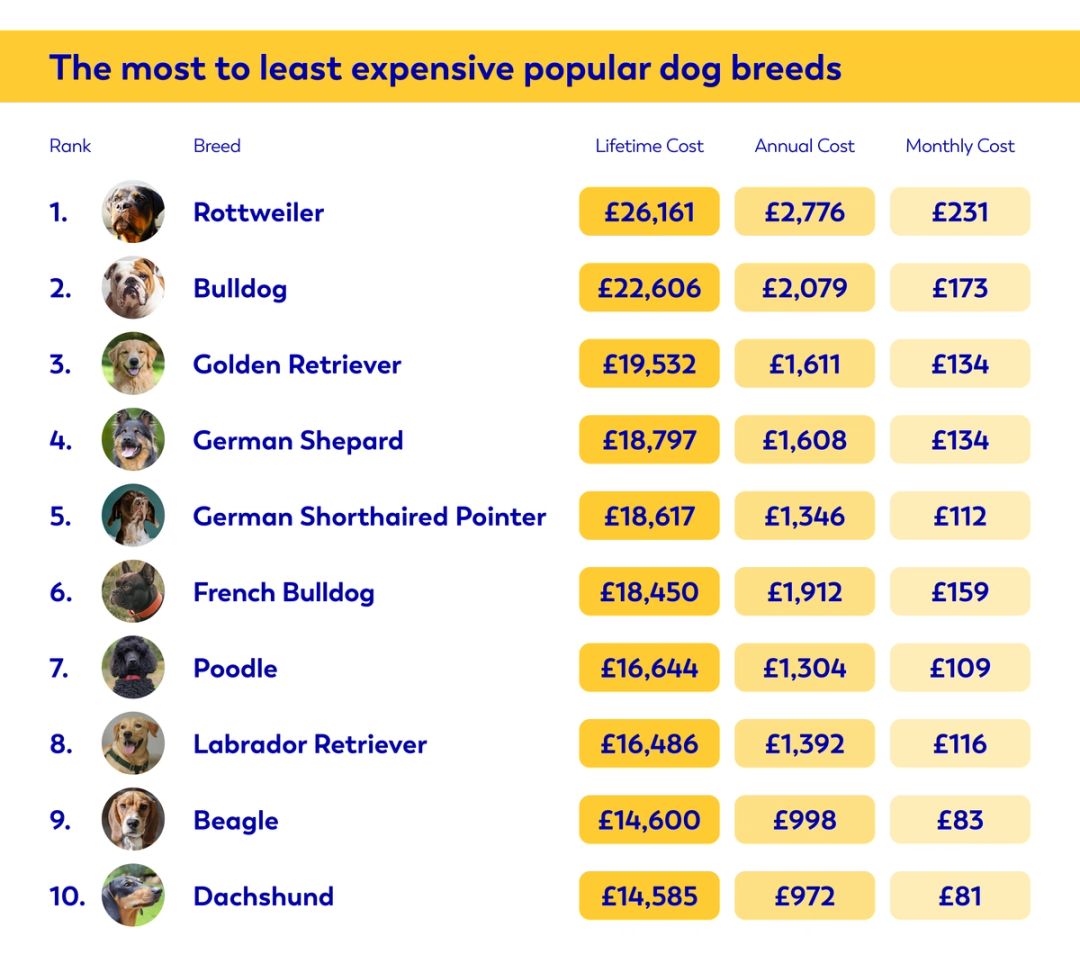The true cost of owning a pet
Aqua’s latest research reveals the most and least expensive cat and dog breeds to own, and provides top tips for budgeting for a pet.

With an estimated 57% of households in the UK owning a pet, it’s no secret that we’re a nation of animal lovers. However, pets are a big commitment, especially from a financial point of view, so it’s important to consider the costs that can add up over their lifetime. But, which type of pets tend to be the most expensive?
To find out, we analysed 10 of the most popular dog and cat breeds and some of the costs associated with owning them. The research looks at the cost of things like pet insurance, food, and vaccinations, as well as the initial fees to either buy or adopt each breed. We’ve also shared some tips for effectively budgeting for a new furry friend.
It’s important to note, however, that these are just some of the core costs of owning a pet and there are other potential costs involved, including unexpected vet bills or daycare fees. Everyone’s financial situation is different too, so costs will vary depending on things such as the type of pet food, and the level of insurance you choose.
The most and least expensive dog breeds
When looking at the basic expenses associated with adding a dog to the family, including purchasing costs, food requirements, grooming fees, vaccinations, and insurance, we found that costs can vary quite a lot between breeds.

According to our research, the most expensive dog breed to own in the UK is a Rottweiler. With dogs of this breed tending to live for around nine years, the average lifetime cost of owning a Rottweiler is £26,160. Buying a Rottweiler puppy will cost around £1,152, however adopting one at any age is a lot more affordable, with adoption fees averaging £208.
Having a good level of pet insurance is important for keeping your animal healthy, and Rottweilers are the most expensive of all dog breeds in the study to insure, with standard level cover averaging £1,509 per year. It’s also one of the most expensive breeds when it comes to grooming, with one session costing £62, on average. Given the size of Rottweilers, it’s perhaps no surprise that they are also the most expensive type of dog to feed, with food costing around £2.33 per day based on the recommended dry food allowance. This equates to an average of £850 per year.
In second place are English Bulldogs, costing an average of £22,606 throughout their lifetime. While they have a cheaper overall lifetime cost, purchasing an English Bulldog puppy is more expensive than a Rottweiler, with an average cost of £1,790. However, according to the study, English Bulldogs are one of the cheapest breeds to adopt, with fees of around £149.
Known for their shorter coats, it makes sense that they’d also be a breed with lower grooming costs, with one session tending to average £33. They are much more expensive to insure than the likes of a Labrador (£551) or Beagle (£578) though, with yearly fees at £1,443.
On the other end of the spectrum, the cheapest dog breed to own is a Dachshund. Despite having one of the longest average lifespans of 14 years, a Dachshund will cost around £14,585 throughout their time — which is over £10,000 less than the cost of the most expensive breed, the Rottweiler.
Dachshunds are the cheapest breed to buy as a puppy compared with any other dog in the study, with purchasing costs averaging £963. Meanwhile, for those looking to adopt, fees are roughly £257. Due to their short coats, a typical grooming session is about £29 — which is significantly cheaper than many other breeds analysed in the study, such as a Poodle (£52) or a German Shepherd (£51).
Given that they tend to weigh an average of just 10.90 kilograms, Dachshunds are also one of the cheapest dogs to feed, with costs averaging 55p per day, or £201 per year.
The most and least expensive cat breeds
For the feline lovers among us, we also analysed which cat breeds are the most and least expensive to own over their lifetime, by exploring the cost to purchase, food requirements, vaccinations, cat litter costs, and insurance. As many cat owners tend to groom their cats at home, grooming costs weren’t factored into the overall lifetime costs.

Taking the crown as the most expensive breed of cat to own is the Savannah cat. Living to an average age of 15 years, this particular breed costs owners around £25,219 across its lifetime. The Savannah cat is a hybrid of a serval wildcat and a domestic cat and is the most expensive type of kitten to buy, costing around £1,229. In comparison, the cheapest kitten to purchase is a Siamese, with costs averaging £569.
Weighing in at an average of 8.4 kilograms, the Savannah cat is the most expensive cat to feed, costing approximately £1.86 per day. This means owners could be spending around £679 each year on food. With insurance premiums estimated at £603 for the year, it’s also the second most expensive breed of cat to insure.
Costing owners an average of £21,982 throughout its life, the second most expensive type of cat is a Maine Coon. Looking at ongoing costs, the Maine Coon is the most expensive breed to insure of all cat breeds analysed, with a standard insurance policy costing roughly £673 per year. These large cats also cost £1.58 a day to feed — the second-highest price of all cats in the study.
However, it’s slightly cheaper to purchase a Maine Coon kitten than a Savannah cat, with prices at £983, on average. For those open to rescuing one, regardless of their age, adoption fees are as low as £190.
On the other end of the price spectrum, the British Shorthair has come in as the cheapest cat breed to own. This breed will cost owners around £12,732 across their 10-year lifespan. Initially, a British Shorthair kitten is about £894 to buy, though it’s the cheapest cat breed to adopt, at just £43. It also ties with the Ragdoll as the cheapest cat breed to insure, with premiums averaging £457.
Top tips on budgeting for a pet
1. Research, research, research
First things first, do your research. To keep costs down, look into which breeds might require lower maintenance, and which might have less risk of health issues or genetic disorders.
For example, large breeds, such as German Shepherds, are prone to hip issues, while dogs with long backs, such as Dachshunds, can often suffer from spinal problems, according to WebMD. So, if there is a particular breed you are interested in, do your research to make sure you understand the costs you might face later down the line and make sure you factor this into your budget. Animals that are more prone to health problems can require more trips to the vet, which of course leads to higher bills.
2. Plan for initial fees
The initial costs of getting a pet tend to be more substantial than in subsequent years. Not only do you need to factor in the cost of purchasing (or adopting) your pet, but you also need to combine this with first-time vaccinations, vet bills, and new accessories.
If you’re able to, it’s worth saving up enough for the first year before bringing home your new pet, so you have full peace of mind you can care for it. Also keep in mind that if your pet has health problems as it ages, this can lead to more vet bills and higher insurance premiums over time.
3. Create a pet care budget
You also need to plan for the ongoing costs, so that’s things like food, waste bags, grooming, or litter. Monitoring how frequently you have to purchase these items can be helpful, so you can then create a specific budget that incorporates how much you need to spend on pet care each month.
If you already have a monthly financial budget for you or your family, make sure your new pet is now included in this too.
4. Prepare for the unexpected
As with any financial responsibility, you have to prepare for the unexpected. This might come in the form of a medical emergency, for instance, if you have to rush your pet to the vet, or it might just be that you need to put your animal in a kennel or a cattery while you’re away. Setting aside money each month can help budget for this, so you’ve got a cushion to fall back on if you’re hit with unexpected costs.
With that said, some pet emergencies can incur significant fees, so having a good level of pet insurance is important. In general, pet insurance can cover you for things like veterinary bills, third-party liability, boarding or hospitalisation costs, and overseas vet fees if you’re away.
Sources & Methodology
Aqua pulled together a seed list of the top 10 most popular cat and dog breeds. The study then analysed the following for each breed:
Cost of insurance - per year
Cost to buy - as a puppy or kitten
Cost to adopt - at any age
Cost of kitten/puppy vaccinations and boosters
Dry food allowance for cat/dog
Cost of food for cat/dog - calculated using dry food allowance, cost is per day
Cat litter cost - per year
Lifespan of each breed of cat/dog
Cost of grooming for dog - per session, yearly average calculated based on dogs going to groomers six times a year. Overall lifetime costs for cats were calculated without grooming fees, due to many cat owners choosing to groom their pet themselves.
The research then calculated the initial first-year cost of owning a pet, and then the ongoing annual cost. The ongoing costs were then multiplied by each breed’s average lifespan and added to initial first-year costs to determine the lifetime cost of each breed.
Failure to make payments on time or to stay within your credit limit means that you will pay additional charges and may make obtaining credit in the future more expensive and difficult.
Contributors

Victoria Smith
Victoria is an editor at Aqua.

Vanessa Stewart
Vanessa is an editor at Aqua.
You might also like
Slide 1 of 3
The Social Tax: UK adults overspend by £800 d...
Over a quarter of those surveyed said they overspend due to the fear of missing out.
Sharvan Selvam

Everyday budgeting
Budgeting bills and everyday budgeting tips.
Sharvan Selvam

Savvy holiday spending
Aqua explores the holiday spending habits of people across the UK.
Sharvan Selvam
The smart way to build better credit
Aqua is the credit card that gives you the power to improve your credit score
